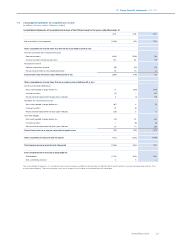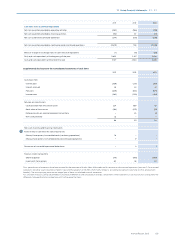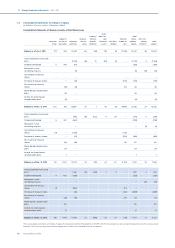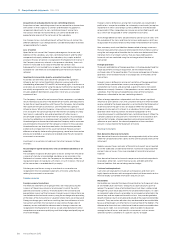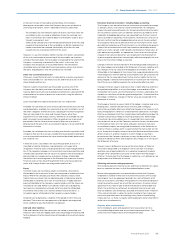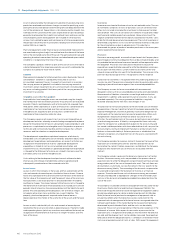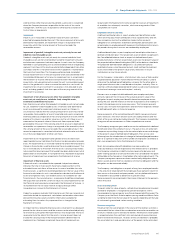Philips 2013 Annual Report Download - page 139
Download and view the complete annual report
Please find page 139 of the 2013 Philips annual report below. You can navigate through the pages in the report by either clicking on the pages listed below, or by using the keyword search tool below to find specific information within the annual report.
11 Group financial statements 11.9 - 11.9
Annual Report 2013 139
In the event of sale of receivables and factoring, the Company
derecognizes receivables when the Company has given up control or
continuing involvement, which is deemed to have occurred when:
• the Company has transferred its rights to receive cash flows from the
receivables or has assumed an obligation to pay the received cash
flows in full without any material delay to a third party under a ‘pass-
through’ arrangement; and
• either (a) the Company has transferred substantially all of the risks and
rewards of the ownership of the receivables, or (b) the Company has
neither transferred nor retained substantially all of the risks and
rewards, but has transferred control of the assets.
However, in case the Company neither transfers nor retains substantially
all the risks and rewards of ownership of the receivables nor transfers
control of the receivables, the receivable is recognized to the extent of the
Company’s continuing involvement in the assets. In this case, the
Company also recognizes an associated liability. The transferred
receivable and associated liability are measured on a basis that reflects
the rights and obligations that the Company has retained.
Other non-current financial assets
Other non-current financial assets include held-to-maturity investments,
loans and available-for-sale financial assets and financial assets at fair
value through profit or loss.
Held-to-maturity investments are those debt securities which the
Company has the ability and intent to hold until maturity. Held-to-
maturity debt investments are recorded at amortized cost, adjusted for the
amortization or accretion of premiums or discounts using the eective
interest method.
Loans receivable are stated at amortized cost, less impairment.
Available-for-sale financial assets are non-derivative financial assets that
are designated as available-for-sale and that are not classified in any of
the other categories of financial assets. Subsequent to initial recognition,
they are measured at fair value and changes therein, other than
impairment losses and foreign currency dierences on available for sale-
debt instruments are recognized in Other comprehensive income and
presented in the fair value reserve in equity. When an investment is
derecognized, the gain or loss accumulated in equity is reclassified to the
Statement of income.
Available-for-sale financial assets including investments in privately-held
companies that are not associates, and do not have a quoted market price
in an active market and whose fair value could not be reliably determined,
are carried at cost.
A financial asset is classified as fair value through profit or loss if it is
classified as held for trading or is designated as such upon initial
recognition. Financial assets are designated as fair value through profit or
loss if the Company manages such investments and makes purchase and
sale decisions based on their fair value in accordance with the Company-
documented risk management or investment strategy. Attributable
transaction costs are recognized in the Statement of income as incurred.
Financial assets at fair value through profit or loss are measured at fair
value, and changes therein are recognized in profit or loss.
Equity
Common shares are classified as equity. Incremental costs directly
attributable to the issuance of shares are recognized as a deduction from
equity. Where the Company purchases the Company’s equity share
capital (treasury shares), the consideration paid, including any directly
attributable incremental costs (net of income taxes) is deducted from
equity attributable to the Company’s equity holders until the shares are
cancelled or reissued. Where such ordinary shares are subsequently
reissued, any consideration received, net of any directly attributable
incremental transaction costs and the related income tax eects, is
included in equity attributable to the Company’s equity holders.
Dividends are recognized as a liability in the period in which they are
declared. The income tax consequences of dividends are recognized
when a liability to pay the dividend is recognized.
Debt and other liabilities
Debt and liabilities other than provisions are stated at amortized cost.
However, loans that are hedged under a fair value hedge are remeasured
for the changes in the fair value that are attributable to the risk that is being
hedged.
Derivative financial instruments, including hedge accounting
The Company uses derivative financial instruments principally to manage
its foreign currency risks and, to a more limited extent, for managing
interest rate and commodity price risks. All derivative financial instruments
are classified as current assets or liabilities and are accounted for at the
trade date. Embedded derivatives are separated from the host contract
and accounted for separately if the economic characteristics and risks of
the host contract and the embedded derivative are not closely related.
The Company measures all derivative financial instruments at fair value
derived from market prices of the instruments, or calculated as the present
value of the estimated future cash flows based on observable interest
yield curves, basis spread, credit spreads and foreign exchange rates, or
from option pricing models, as appropriate. Gains or losses arising from
changes in fair value of derivatives are recognized in the Statement of
income, except for derivatives that are highly eective and qualify for cash
flow or net investment hedge accounting.
Changes in the fair value of derivatives that are designated and qualify as
fair value hedges are recorded in the Statement of income, together with
any changes in the fair value of the hedged asset or liability that are
attributable to the hedged risk. For interest rate swaps designated as a fair
value hedge of an interest bearing asset or liability that are unwound, the
amount of the fair value adjustment to the asset or liability for the risk
being hedged is released to the Statement of income over the remaining
life of the asset or liability based on the recalculated eective yield.
Changes in the fair value of a derivative that is highly eective and that is
designated and qualifies as a cash flow hedge, are recorded in Other
comprehensive income, until the Statement of income is aected by the
variability in cash flows of the designated hedged item. To the extent that
the hedge is ineective, changes in the fair value are recognized in the
Statement of income.
The Company formally assesses, both at the hedge’s inception and on an
ongoing basis, whether the derivatives that are used in hedging
transactions are highly eective in osetting changes in fair values or cash
flows of hedged items. When it is established that a derivative is not highly
eective as a hedge or that it has ceased to be a highly eective hedge, the
Company discontinues hedge accounting prospectively. When hedge
accounting is discontinued because it is expected that a forecasted
transaction will not occur, the Company continues to carry the derivative
on the Balance sheet at its fair value, and gains and losses that were
accumulated in equity are recognized immediately in the Statement of
income. If there is a delay and it is expected that the transaction will still
occur, the amount in equity remains there until the forecasted transaction
aects income. In all other situations in which hedge accounting is
discontinued, the Company continues to carry the derivative at its fair
value on the Balance sheet, and recognizes any changes in its fair value in
the Statement of income.
Foreign currency dierences arising on the retranslation of financial
instruments designated as a hedge of a net investment in a foreign
operation are recognized directly as a separate component of equity
through Other comprehensive income, to the extent that the hedge is
eective. To the extent that the hedge is ineective, such dierences are
recognized in the Statement of income.
Osetting and master netting agreements
The Company presents financial assets and financial liabilities on a gross
basis as separate line items in the Consolidated balance sheet.
Master netting agreements may be entered into when the Company
undertakes a number of financial instrument transactions with a single
counterparty. Such an agreement provides for a net settlement of all
financial instruments covered by the agreement in the event of default or
certain termination events on any of the transactions. A master netting
agreement may create a right of oset that becomes enforceable and
aects the realization or settlement of individual financial assets and
financial liabilities only following a specified termination event. However,
if this contractual right is subject to certain limitations then it does not
necessarily provide a basis for osetting unless both of the osetting
criteria are met, i.e. there is a legally enforceable right and an intention to
settle net or simultaneously.
Property, plant and equipment
Items of property, plant and equipment are measured at cost less
accumulated depreciation and accumulated impairment losses. The
useful lives and residual values are evaluated annually.




